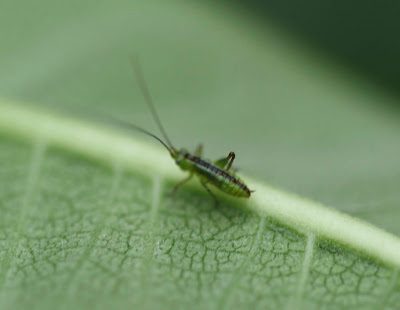 |
| Big brown bat. |
Canoe Creek State Park is famous for both the striking ruins of the Blair Limestone Kilns and for its bats. An abandoned church was acquired by the park after it was found to contain a colony of around 30,000 bats, and it is now an official bat sanctuary.
White nose syndrome recently devastated the bat population, and the bats are ever so slowly trying to recover. My family and I visited to hear John Chenger of
Bat Conservation and Management talk about bats and show us survey techniques. It was very cool!
 |
| Blair Limestone Kilns. |
We learned that bats are significantly important for many reasons. They are a hugely important check on the insect population, which would otherwise devastate our crops and forests. In fact, weather radar can provide images of clouds of migrating moths crossing the Gulf of Mexico being met by clouds of bats emerging in the evening, like something from a superhero movie! Bats also are pollinators of some unique night blooming flowers, such as the iconic saguaro cactus. And fruit bats spread the seeds of plants for many miles. Bats used to fill the night sky in dense clouds, much like passenger pigeons once did during the day. But humans killing bats deliberately from irrational fear and carelessly from habitat loss and pesticide poisoning have seriously harmed their numbers. And then white nose syndrome came along, and the bat population has been devastated. Many colonies have seen 100% mortality rates. The main colony at Canoe Creek that was once 30,000 strong is starting to rebound with numbers close to 200.
Conservation really depends on data. People are not going to work to put measures in place to conserve anything without the numbers to show that it's necessary. But bats are especially difficult to study. They are strictly nocturnal, they fly, and while they are actually quite loud, their cries are outside the range of human ears. In the past, it was possible to count the bats that spent the winter hibernating together, but those are the very bats that have been wiped out. It's important to know what the status is of other bat species.
First we visited the bat sanctuary, and got to see a big brown bat up close. It was quite small! So I assume little brown bats must be way tiny. Then we went to the limestone kilns, where we got to see a huge variety of bat survey equipment in action. A microphone was placed on a telescoping pole in an effort to detect echolocation sounds. The pitch of echolocation sounds are characteristic of different species, which is very useful. Three mist nets were set up. We got to check out a wide variety of bat detection equipment, including a really cool thermal camera. All the paraphernalia intended to detect something invisible to the eye reminded me very much of being on a ghost hunt. Mr. Chenger explained that it's often challenging for well intentioned folks using bat detectors to actually know if their equipment is working properly!
Mr. Chenger set up the mist nets strategically. Mist nets are easily detected by bats if they are using echolocation. But he explained that it's like screaming at the top of their lungs. So they often have routes they take every night to hunt for bugs, and if they know the route by heart they may rely on memory. He chose spots along a creek and along a trail where the tree canopy would constrict their flight. He was hoping to be able to show us an eastern red bat, but instead he caught another big brown bat. Apparently neither population has been severely affected by white nose syndrome, so they may be filling the niche left by the decimated little brown bats. We didn't mind because it was amazing to see another wild bat up close. We also got to see a northern red salamander, which was hanging out in the creek.
 |
| Limestone quarry. |
 |
| Milkweed. |
 |
| Jewelweed. |
 |
| Daisy fleabane. |
 |
| Tall bellflower. |
 |
| Wild bergamot. |
 |
| Northern red salamander. |
 |
| Big brown bat. |
 |
| A view of the limekilns through the thermal imaging camera. |
 |
| A view of the trees through the thermal imaging camera. |
 |
| Gently removing the bat from the mist net. |
 |
| Measuring the bat for survey data. |
 |
| The bat was placed inside a bag briefly in order to weigh it. |





























Comments
Post a Comment
Hello! I love to read your comments, but please be aware that they are moderated. This will result in a delay before they are posted. Thank you for your patience.